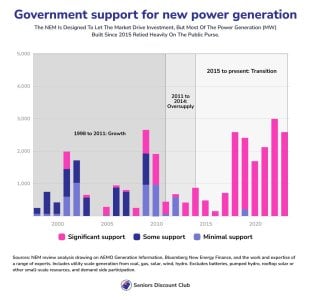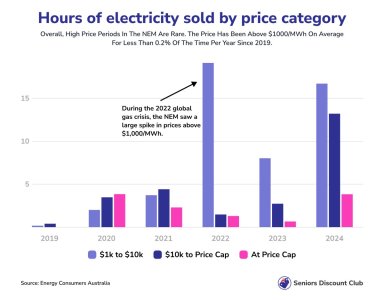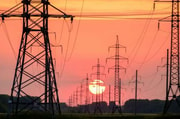
Just when you thought electricity bills couldn't get any more eye-watering, Australia's wholesale power market has quietly broken new ground.
The country's electricity market cap—the maximum price power can reach during any half-hour trading period—jumped to $20,300 per megawatt hour on 1 July 2026, making it officially among the highest in the world.
But here's the kicker: consumer advocates say this sky-high ceiling isn't achieving what it's supposed to—encouraging new power generation—while households are being slugged with the costs.
In this article
What exactly is this market cap?
Think of the market cap like a speed limit, except instead of limiting how fast cars can go, it limits how expensive electricity can get during any 30-minute period. The market price cap is the maximum price that can be reached on the spot market during any dispatch and trading interval.
How the electricity market cap affects your bill
While wholesale electricity makes up about 40 per cent of your retail bill, most of the time wholesale prices sit well below the cap at around $50-100 per megawatt hour.
However, when the grid is stressed—during heatwaves, equipment failures, or transmission line problems—prices can spike to the maximum cap level.
Even a few hours at these extreme prices can significantly increase wholesale costs that eventually flow through to household bills.
Previously, the cap sat at $18,600 per megawatt hour. This jump to $20,300 marks the first of three significant increases in line with an Australian Energy Market Commission rule determination made back in December 2023, with the cap set to reach almost $27,000 by 2028.
A system that's not working as intended
Consumer advocate Brian Spak from Energy Consumers Australia puts it bluntly: the current system appears to be failing on both fronts.
'All of the research seems to suggest no, it has not been providing an incentive for new generation, and it hasn't for a long time'
The market price cap increase was higher than regulators had flagged in their March draft, with wholesale and network costs increasing by between 1 per cent and 11 per cent, and retail costs rising by 8 per cent to 35 per cent over the past year.
The theory behind allowing such extreme prices is simple: when electricity becomes expensive enough, it should encourage companies to build new power plants. But since 2012, all new large-scale generation built in the national electricity market has relied upon significant government support rather than being driven by high market prices.

The real-world impact on your household budget
Recent market events show how quickly these extreme prices can bite. In late January 2025, demand across the National Electricity Market jumped to unprecedented levels, setting a new record of 34,843MW, leading to prices that stayed high for much of the day and price caps being imposed in Victoria and South Australia.
More recently, prices for the June 2025 quarter were primarily driven by high price events that occurred over just 3 days towards the end of the quarter on 11, 12 and 26 June 2025.
The impact on household budgets is becoming clearer through official statistics. Living costs for age pensioner households rose 1.0 per cent in the June 2025 quarter, with households represented by these indexes sourcing their principal income from government payments.
Seniors feeling the pinch more than others
Government payment recipients, including age pensioners, are experiencing some of the steepest rises in living costs. Households with government payments as their main source of income saw the largest annual rises in living costs this quarter due to rises in electricity costs, experiencing a larger impact from energy rebates being used up compared to other household types.
The numbers tell a concerning story: the Pensioner and Beneficiary Living Cost Index rose 2.9 per cent in the 12 months to June 2025, compared to an annual rise of 2.1 per cent in the general Consumer Price Index.
Managing your electricity costs
- Take advantage of government rebates while they're available—most are applied automatically
- Consider switching electricity providers—comparison websites can help identify cheaper deals
- Look into concessions available for seniors and pensioners in your state
- Explore rooftop solar options if you own your home—potential savings of $1,500+ per year
- Check if you're eligible for hardship programs if you're struggling with bills
How does Australia really compare internationally?
While some reports suggest Australia has the world's highest electricity prices, the reality is more nuanced. Australia sits 15th most expensive out of 38 OECD countries for household electricity according to Global Petrol Prices, while Compare the Market puts Australia at 13th most expensive among 29 similar economies.
Australia placed almost exactly in the middle of the pack during June 2024, coming in as the 13th most expensive country within the study, with a June 2024 average household electricity rate of US$0.246/kWh.
However, what makes Australia unique isn't necessarily the retail prices households pay, but the wholesale market design that allows such extreme price spikes.
The 'missing money' problem driving price spikes
The electricity industry has a term for what's happening: the 'missing money' problem. This refers to the recognition that a market clearing at short-run marginal cost, even for the most expensive generator, fails to provide sufficient revenue to cover long-run capital costs.
In South Australia, negative prices accounted for about 25 per cent of the hours on average annually in both 2023 and 2024—meaning there are times when there's so much renewable energy that generators actually pay to give electricity away. But then, when the wind stops blowing and the sun stops shining, prices can rocket to the maximum cap.
In 2024, the average price of electricity from fossil fuels was $137 per megawatt hour, almost twice the average price of electricity from renewables ($71 per MWh), because coal and gas-fired power stations pay international prices for these fossil fuels.

Government rebates providing temporary relief
The federal government has recognised the strain on household budgets, implementing comprehensive rebate programs. Australian households and eligible small businesses with electricity bills may receive up to $150 in energy bill rebates from 1 July 2025 to the end of 2025, with rebates automatically applied to electricity bills in two $75 quarterly instalments.
Despite two consecutive quarterly rises in electricity, the series has recorded a fall of 6.2 per cent over the past 12 months due to the introduction of the second round of Commonwealth Energy Bill Relief Fund rebates from July 2024.
But these rebates come with a catch—households saw a larger impact from rebates in Perth and Queensland being used up compared to other household types as they have relatively smaller electricity bill sizes, which means the increase had a proportionally bigger impact on their out-of-pocket electricity costs.
Did you know?
Did you know?
Despite government rebates reducing headline electricity price rises, excluding the rebates, electricity prices would have risen by 0.4 per cent in the June 2025 quarter, showing that underlying cost pressures remain strong.
Looking ahead: More increases on the horizon
The market cap increases are locked in for the next few years. This adjustment is the first of a three-part staged increase to the market price cap base rate through to the 2027-28 financial year, with the market price cap beginning the first of three scheduled increases from July 2025.

Meanwhile, residents of NSW face power price rises of between 7.8 per cent and 8.9 per cent, costing an extra $159 to $249 annually for households with average energy consumption, while households in south-east Queensland will pay an extra 2.5 per cent to 5.8 per cent, or $61 to $119 on average.
What This Means For You
The question remains whether this expensive experiment in market design will eventually deliver the reliable, affordable electricity system it promises—or whether Australian households will continue bearing the cost of a system that benefits few while burdening many.
What's your experience been with recent electricity bill increases? Have the government rebates made a meaningful difference to your household budget, and what other strategies have you found helpful for managing rising energy costs?
Original Article
https://www.abc.net.au/news/2025-09...t-allows-world-highest-price-spikes/105673588
Market Price Cap increases to $20,300/MWh from today, 1st July 2025—WattClarity
Cited text: The AEMC has announced that the Market Price Cap will increase to $20,300/MWh from 1st July 2025.
Excerpt: $20,300 per megawatt hour from July 1, 2025
https://wattclarity.com.au/articles...reases-to-20300-mwh-from-today-1st-july-2025/
Market Price Cap increases to $20,300/MWh from today, 1st July 2025—WattClarity
Cited text: Posted by Dan LeeTuesday 1st July 2025 11:45 AM Topic: Market Reform · With the new financial year beginning today, the Market Price Cap (MPC) in the ...
Excerpt: $20,300 per megawatt hour from July 1, 2025
https://wattclarity.com.au/articles...reases-to-20300-mwh-from-today-1st-july-2025/
AEMC updates market price cap for 2025-26 | AEMC
Cited text: · The MPC is the maximum price that can be reached on the spot market during any dispatch and trading interval.
Excerpt: The market price cap is the maximum price that can be reached on the spot market during any dispatch and trading interval
https://www.aemc.gov.au/news-centre/media-releases/aemc-updates-market-price-cap-2025-26
Is the price right? A historical exploration into the NEM’s price cap—WattClarity
Cited text: This change is the first of three significant increases in line with an AEMC rule determination made back in December 2023.
Excerpt: This change is the first of three significant increases in line with an Australian Energy Market Commission rule determination made back in December 2023
https://wattclarity.com.au/articles...torical-exploration-into-the-nems-market-cap/
Amendment of the Market Price Cap, Cumulative Price Threshold and Administered Price Cap | AEMC
Cited text: On 7 December 2023, the Australian Energy Market Commission (AEMC) made a more preferable final rule to amend the market price settings in the NEM for...
Excerpt: This change is the first of three significant increases in line with an Australian Energy Market Commission rule determination made back in December 2023
https://www.aemc.gov.au/rule-change...ve-price-threshold-and-administered-price-cap
Australia: Electricity prices to rise by up to 10 percent—World Socialist Web Site
Cited text: The DMO increase was higher than the regulator had flagged in its March draft offer, citing a faster than anticipated rise in the cost of electricity ...
Excerpt: The market price cap increase was higher than regulators had flagged in their March draft, with wholesale and network costs increasing by between 1 per cent and 11 per cent, and retail costs rising by 8 per cent to 35 per cent over the past year
https://www.wsws.org/en/articles/2025/06/11/nbww-j11.html
Is the price right? A historical exploration into the NEM’s price cap—WattClarity
Cited text: However, in the 2000s, American economists Peter Cramton and Steven Stoft articulated what became known as the “Missing Money Problem“—the recognition...
Excerpt: since 2012, all new large-scale generation built in the national electricity market has relied upon significant government support
https://wattclarity.com.au/articles...torical-exploration-into-the-nems-market-cap/
Market Price Cap increases to $20,300/MWh from today, 1st July 2025—WattClarity
Cited text: ... Wednesday 28th January saw demand across the NEM jump to unprecedented levels, setting a new record of 34,843MW at 16:00 NEM time. On Thursday 29t...
Excerpt: In late January 2025, demand across the National Electricity Market jumped to unprecedented levels, setting a new record of 34,843MW, leading to prices that stayed high for much of the day and price caps being imposed in Victoria and South…
https://wattclarity.com.au/articles...reases-to-20300-mwh-from-today-1st-july-2025/
Wholesale charts | Australian Energy Regulator (AER)
Cited text: Prices for the quarter were primarily driven by high price events that occurred over 3 days towards the end of the quarter on 11, 12 and 26 June 2025.
Excerpt: More recently, prices for the June 2025 quarter were primarily driven by high price events that occurred over just 3 days towards the end of the quarter on 11, 12 and 26 June 2025
https://www.aer.gov.au/industry/wholesale/charts
Selected Living Cost Indexes, Australia, June 2025 | Australian Bureau of Statistics
Cited text: · Living costs for Age pensioner (+1.0 per cent) and Other government transfer recipient (+1.0 per cent) households and the Pensioner and Beneficiary LCI (PBLCI) (+1....
Excerpt: Living costs for age pensioner households rose 1.0 per cent in the June 2025 quarter, with households represented by these indexes sourcing their principal income from government payments
https://www.abs.gov.au/statistics/e...-living-cost-indexes-australia/latest-release
Living costs rise for all household types | Australian Bureau of Statistics
Cited text: · Households with government payments as their main source of income saw the largest annual rises in living costs this quarter due to rises in electri...
Excerpt: Households with government payments as their main source of income saw the largest annual rises in living costs this quarter due to rises in electricity costs, experiencing a larger impact from energy rebates being used up compared to…
https://www.abs.gov.au/media-centre/media-releases/living-costs-rise-all-household-types
Living costs rise for all household types | Australian Bureau of Statistics
Cited text: The PBLCI rose 2.9 per cent in the 12 months to June 2025 quarter, compared to an annual rise of 2.1 per cent in the CPI.
Excerpt: the Pensioner and Beneficiary Living Cost Index rose 2.9 per cent in the 12 months to June 2025, compared to an annual rise of 2.1 per cent in the general Consumer Price Index
https://www.abs.gov.au/media-centre/media-releases/living-costs-rise-all-household-types
Experts warn of 'problematic' power price comparisons | AAP
Cited text: When looking at OECD countries, Australia sits 15th most expensive out of 38 countries for household electricity, according to the Global Petrol Price...
Excerpt: Australia sits 15th most expensive out of 38 OECD countries for household electricity according to Global Petrol Prices, while Compare the Market puts Australia at 13th most expensive among 29 similar economies
https://www.aap.com.au/factcheck/experts-warn-of-problematic-power-price-comparisons/
Changes in Electricity Prices Globally | Compare the Market
Cited text: Australia placed almost exactly in the middle of the pack during June 2024, coming in as the 13th most expensive (or 17th cheapest!) country within th...
Excerpt: Australia placed almost exactly in the middle of the pack during June 2024, coming in as the 13th most expensive country within the study, with a June 2024 average household electricity rate of US$0.246/kWh
https://www.comparethemarket.com.au/energy/features/changes-in-electricity-prices-globally/
Prices—Electricity 2025—Analysis—IEA
Cited text: In South Australia, negative prices accounted for about 25 per cent of the hours on average annually in both 2023 and 2024.
Excerpt: In South Australia, negative prices accounted for about 25 per cent of the hours on average annually in both 2023 and 2024
https://www.iea.org/reports/electricity-2025/prices
Five reasons why your power bills are sky high—and how you can help bring them down | Climate Council
Cited text: In 2024, the average price of electricity from fossil fuels was $137 per megawatt hour (MWh), almost twice the average price of electricity from renew...
Excerpt: In 2024, the average price of electricity from fossil fuels was $137 per megawatt hour, almost twice the average price of electricity from renewables ($71 per MWh), because coal and gas-fired power stations pay international prices for…
https://www.climatecouncil.org.au/four-reasons-why-your-power-prices-are-sky-high-and-rising/
Energy Bill Relief Fund | energy.gov.au
Cited text: Australian households and eligible small businesses with electricity bills may receive up to $150 in energy bill rebates from 1 July 2025 to the end o...
Excerpt: Australian households and eligible small businesses with electricity bills may receive up to $150 in energy bill rebates from 1 July 2025 to the end of 2025, with rebates automatically applied to electricity bills in two $75 quarterly…
https://www.energy.gov.au/energy-bill-relief-fund
Consumer Price Index, Australia, June Quarter 2025 | Australian Bureau of Statistics
Cited text: Despite two consecutive quarterly rises in electricity, the series has recorded a fall of 6.2 per cent over the past 12 months. The annual fall is due...
Excerpt: Despite two consecutive quarterly rises in electricity, the series has recorded a fall of 6.2 per cent over the past 12 months due to the introduction of the second round of Commonwealth Energy Bill Relief Fund rebates from July 2024
https://www.abs.gov.au/statistics/e...consumer-price-index-australia/latest-release
Selected Living Cost Indexes, Australia, June 2025 | Australian Bureau of Statistics
Cited text: These households saw a larger impact from the EBRF and State government rebates in Perth and Queensland being used up compared to other household type...
Excerpt: households saw a larger impact from rebates in Perth and Queensland being used up compared to other household types as they have relatively smaller electricity bill sizes, which means the increase had a proportionally bigger impact on…
https://www.abs.gov.au/statistics/e...-living-cost-indexes-australia/latest-release
Consumer Price Index, Australia, June Quarter 2025 | Australian Bureau of Statistics
Cited text: · Excluding the rebates, electricity prices would have risen by 0.4 per cent in the June 2025 quarter.
Excerpt: excluding the rebates, electricity prices would have risen by 0.4 per cent in the June 2025 quarter
https://www.abs.gov.au/statistics/e...consumer-price-index-australia/latest-release
Market Price Cap increases to $20,300/MWh from today, 1st July 2025—WattClarity
Cited text: This adjustment is the first of a three-part staged increase to the MPC base rate through to the 2027-28 financial year.
Excerpt: This adjustment is the first of a three-part staged increase to the market price cap base rate through to the 2027-28 financial year, with the market price cap beginning the first of three scheduled increases from July 1st 2025
https://wattclarity.com.au/articles...reases-to-20300-mwh-from-today-1st-july-2025/
Market Price Cap increases to $20,300/MWh from today, 1st July 2025—WattClarity
Cited text: From July 1st 2025, the MPC will begin the first of three scheduled increases.
Excerpt: This adjustment is the first of a three-part staged increase to the market price cap base rate through to the 2027-28 financial year, with the market price cap beginning the first of three scheduled increases from July 1st 2025
https://wattclarity.com.au/articles...reases-to-20300-mwh-from-today-1st-july-2025/
Australia: Electricity prices to rise by up to 10 percent—World Socialist Web Site
Cited text: [Photo by CSIRO / CC BY 3.0] Residents of NSW, the country’s most-populous state, face power price rises of between 7.8 percent and 8.9 percent, costi...
Excerpt: residents of NSW face power price rises of between 7.8 per cent and 8.9 per cent, costing an extra $159 to $249 annually for households with average energy consumption, while households in south-east Queensland will pay an extra 2.5 per cent to 5…
https://www.wsws.org/en/articles/2025/06/11/nbww-j11.html







